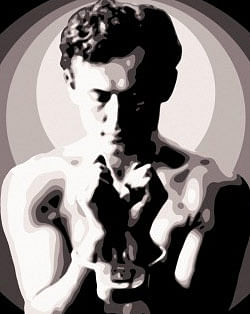Houdini by Clinton Cox
Reviewed by Jamy Ian Swiss (originally published in Genii May, 2002)

Yet another biography on Houdini. Gee, he must have been a great promoter, huh? Or do you think, maybe, now, finally do you think there's something more to it? Do you think that maybe there are substantial reasons why Houdini may turn out to be the greatest superstar in or out of magic of the 20th century?
Only time perhaps another century will tell if that actually turns out to be true, but chances are looking better all the time. Sarah Bernhardt and Harry Lauder and Al Jolson and Bing Crosby and Martin & Lewis were all superstars in their time, not unlike Madonna and Michael Jackson today, but most of these and others like them have already melted down in the wax museum of pop culture consciousness, and a century from now the icon who remains standing tallest might yet turn out to be our very own Harry unless of course it turns out to be Elvis. Well, you can't have everything.
This time we have a young people's book published by Scholastic Press and written by award-winning author Clinton Cox, who has previously written four books for Scholastic along with other teenage-targeted histories and biographies. And quite a good book it is, a welcome bit of refreshing sorbet with which to cleanse your palate if the last Houdini work you read possessed the bitter if empty taste of William Rauscher's Houdini Code Mystery.
Although geared for younger audiences my guess would be roughly junior-high age I found the book quite enjoyable, and while a quick read, it didn't feel "dumbed down" or foolish. The author is obviously a competent researcher, and while Ken Silverman's Houdini has obviously been drawn from as a resource, primary sources have also been sought out. There are some interesting photos from the Library of Congress and other collections that have not been widely seen, and quotations drawn from letters that seem to come from primary sources and so do not produce the sense of rehash that is so typical of most Houdini biographical efforts. Serious students may want to read this, even if your junior high school years are far behind you, as you might discover some derails not explored elsewhere. A bit more information seems to see the light of day concerning Houdini's illicit affair with Chairman London, first revealed in the Silverman biography. There are stories of Houdini's patriotism and charity efforts after the outbreak of the First World War that are of interest. It will be frustrating to some, however, that while a bibliography is included, the work is not foot-noted and specific source materials are not cited.
One interesting aspect of this book is the author's chosen approach to secrets and methods. Ken Silverman, himself amateur magician, made a clear-cut choice in Houdini to reveal no methods whatsoever. This was certainly a legitimate and effective option, but it is far from the only or even obvious choice, especially for a biographer who is not a magician. After all, presidents have their secrets too, but eventually, biographers hope to unearth them.
In Mr. Cox's case, he seems to have embraced a middle path. From time to time he makes mention of a method, but this seems intended not to lower the reader's estimation of Houdini's abilities but rather to perhaps raise them, or to at least place them in context; that is, to establish that he was clever and uniquely talented, but that he was human just the same. Thus the occasional reference to a sliding panel or the like might be accompanied by the remark that "Houdini's rare blend of strength, skill, and courage was what made it possible for him to perform the trick."
This seems a reasonable choice, but the author is not always consistent. An explanation of "Walking Through a Brick Wall" seems more prurient than useful, for example, intended to deflate his subject or inflate the author's expertise, rather than to fairly enlighten the reader. What's mom, the author, not being a magician, sometimes finds it difficult to distinguish fantasy from reality in a photo caption he refers to the "Water Torture Cell" as one of Houdini's "most dangerous escapes," when in fact any item that was designed and built by the per-former himself for repeated use upon the stage was certainly far less dangerous than meeting challenges in outdoor conditions or with props built by others. Mr. Cox also seems confused about how harshly to judge the fantasy world of show business, as when he repeatedly refers to Houdini's unarguable ability to "exaggerate" without attempting to distinguish between professional public relations the kind that is no different then from any contemporary story about the star who does his own movie stunts and exaggeration that is somehow egregious or immoral. Failure to clarify these issues and definitions will no doubt be a source of confusion among young readers.
The book is beautifully produced, the exterior consisting of an attractive dust-jacket over a consistently designed laminated cover, matched by a lovely interior of well chosen fonts, chapter headings, and page numbering. The book is a fine introduction to the time-less story of Harry Houdini, and would make a great gift to any interested young person yourself included.
